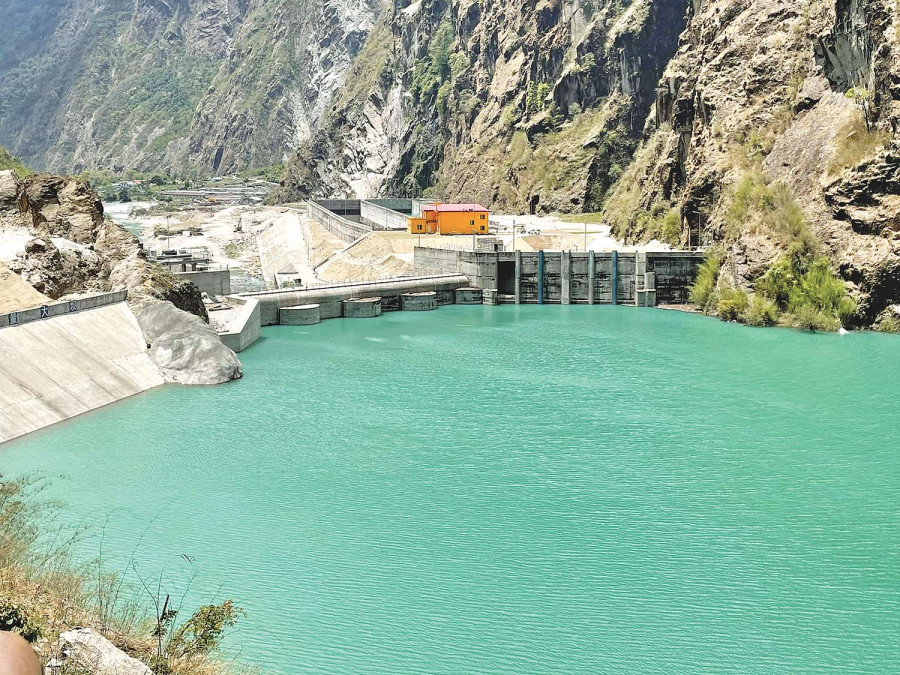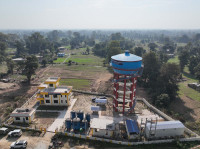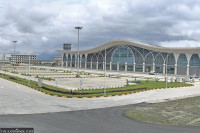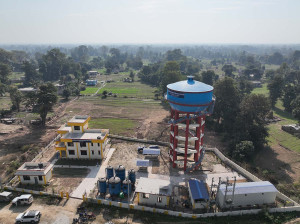Money
Upper Tamakoshi project resumes full power generation
Officials say partial repairs to both desanders allow Nepal’s largest power plant to operate continuously through the monsoon, minimising potential energy losses.
Kedar Shivakoti
Nepal’s largest hydropower plant, the 456-megawatt Upper Tamakoshi project, has resumed round-the-clock electricity generation at full capacity after partial restoration of infrastructure damaged by a landslide and floods last September.
According to the project officials, the plant is now producing at its full capacity around the clock.
In late September last year, a landslide struck above the area housing the desander ponds—the structures to remove sand and silt—an underground culvert, and a control room, causing significant damage to key infrastructure.
As a result, electricity generation was suspended for three months.
By mid-January, the left desander pond had been repaired, and the plant resumed electricity production partially by opening all the dam gates and operating on a run-of-the-river basis.
Purna Gopal Ranjit, project chief, said the partial repair of the right-side desander has allowed the dam to store water, enabling the hydropower station to operate at full capacity.
Last Thursday, the Upper Tamakoshi Hydropower Plant started putting out 456 megawatts, said Ranjit.
He added that while full reconstruction is incomplete, partial operation of both desanders during the three-month monsoon period will help reduce losses.
Full reconstruction of the desanders is expected to take another 45 days.
“If we had waited another month and a half for full repairs, the company would have incurred even greater losses. So, we opted to proceed with partial readiness to begin full-capacity generation,” Ranjit said.
“Repairs of the underground tunnel damaged by the landslide have been completed, and now that the dam is storing water, the plant will continue generating 456 megawatts around the clock until at least October.”
Considering the current monsoon season, Ranjit also said the plant is monitoring flooding conditions carefully during operations.
The hydropower plant is designed for a water discharge of 66 cubic metres per second.
However, during last September's heavy and continuous rainfall, the Tamakoshi river’s flow reached up to 461 cusec at the dam site.
Under the Power Purchase Agreement (PPA) with the Nepal Electricity Authority, the plant must shut down if water flow exceeds 250 cubic metres per second.
Repairs to the damaged underground tunnel have already been completed.
Construction of the plant’s new electricity control room is ongoing. The previous control room was destroyed in the landslide, killing two employees and two army personnel stationed there.
The heavy rainfall in September last year triggered floods and landslides in most parts of the country, causing a loss of Rs46.68 billion to Nepal's economy.
The government reported that the flood significantly damaged Nepal's hydropower sector, with 11 operational projects, including Upper Tamakoshi, experiencing damage.
Following the disaster, the Upper Tamakoshi project filed an insurance claim for Rs1.8 billion to cover damages to civil, electromechanical, electrical, and hydro equipment. The plant can produce Rs40 million worth of electricity daily.
The Upper Tamakoshi project has proven crucial in managing national electricity demands during winter by supplying power as needed. During the dry season, the Nepal Electricity Authority uses the plant as a backup for load management.
Upper Tamakoshi has entered a PPA with the NEA to purchase energy for its entire project capacity at predefined tariffs. The tariff for the wet season (mid-April to mid-December) is Rs3.63 per kWh, while that for the dry season is Rs6.96 per kWh.
The Upper Tamakoshi started its full-fledged commercial operation on September 10, 2021, with all six turbines operating. The project had been partially operational since August 20, 2021, with four units running.
The semi-reservoir-type project operates at full capacity during the monsoon and provides four hours of peak generation in winter.
According to project officials, Upper Tamakoshi Hydropower Company Limited is constructing a new diversion project to bring additional water from the Rolwaling river, increasing its wintertime generation to six hours at full capacity.
This new project will generate an additional 22 megawatts of electricity. The diverted water will be funnelled into the Upper Tamakoshi dam to support continuous operations.




 10.12°C Kathmandu
10.12°C Kathmandu













